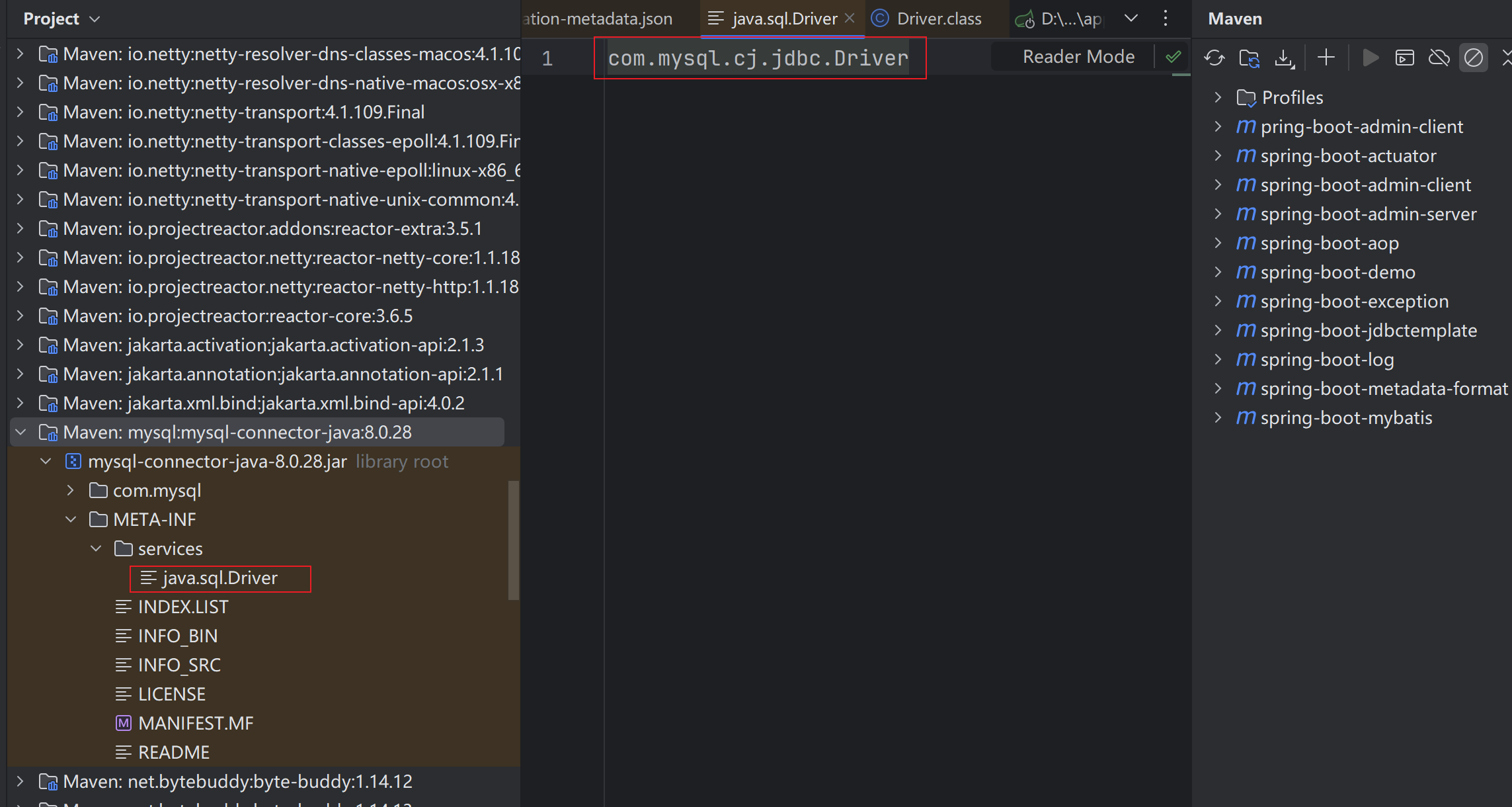spi 机制:
- 在不修改原代码的基础上,通过pom依赖加载别的模块的配置到自己的服务中(个人理解)
- java 可以连接不同的数据库,数据库的驱动各不相同,所以不同的数据库jar声名了这个文件java.sql.Driver,并定义各自的实现com.mysql.cj.jdbc.Driver

简单实现获取resource目录下配置文件信息
- 首先创建配置文件(yfd.properties)
- 纯java代码实现获取配置文件信息,并通过classLoader加载类并创建实体对象
text
yfd=\
com.yfd.spi.Yfd,\
com.yfd.spi.Szljava
public static void main(String[] args) throws ClassNotFoundException, IOException, NoSuchMethodException, InvocationTargetException, InstantiationException, IllegalAccessException {
//1,读取properties文件信息,通过类加载器把配置文件读取到流,或者通过文件流读取
Properties properties = new Properties();
ClassLoader classLoader = ClassLoader.getSystemClassLoader();
InputStream resourceAsStream = classLoader.getResourceAsStream("yfd.properties");
properties.load(resourceAsStream);
//2.根据配置文件的key获取值
String yfd = properties.getProperty("yfd1");
Class<?> aClass = classLoader.loadClass(yfd);
Object o = aClass.getDeclaredConstructor().newInstance();
if (o instanceof Yfd) {
Yfd yfd1 = (Yfd) o;
System.out.println(yfd1);
}
}升级版(依赖其他模块并且resource目录下的配置文件有用相同名称的属性)
- a模块中有这样的yfd.properties
text
yfd=\
com.yfd.spi.Yfd,\
com.yfd.spi.Szl- b模块中有这样的yfd.properties
text
yfd=\
com.yfd.spi.test.Main,\
com.yfd.spi.test.YfdConfig,\
com.yfd.spi.test.YfdUserConfig- a pom文件中依赖了b
- 相对与基础版本
- 实现了配置文件可能多个的读取
- 避免了相同的属性的覆盖
java
/**
* 增强版
*/
public static void main(String[] args) throws IOException, ClassNotFoundException, NoSuchMethodException, InvocationTargetException, InstantiationException, IllegalAccessException {
//1. 通过类加载器获取配置文件
ClassLoader systemClassLoader = ClassLoader.getSystemClassLoader();
Enumeration<URL> resources = systemClassLoader.getResources("yfd.properties");
//2. 遍历配置文件
while (resources.hasMoreElements()) {
//3. 通过Properties 读取流
Properties properties = new Properties();
URL url = resources.nextElement();
InputStream inputStream = url.openStream();
properties.load(inputStream);
//4. 获取当前读取的配置文件中所有的key
Set<String> classKeys = properties.stringPropertyNames();
for (String key : classKeys) {
//5. key对象的vlaue是个字符串数组,如下面这种格式
// yfd=\
// com.yfd.spi.Yfd,\
// com.yfd.spi.Szl
String value = properties.getProperty(key);
String[] split = value.split(",");
for (String itemClassName : split) {
//6. 通过类加载器创建对象
Class<?> aClass = systemClassLoader.loadClass(itemClassName);
Object o = aClass.getDeclaredConstructor().newInstance();
System.out.println(o);
}
}
//7.关闭流
inputStream.close();
}
}把配置文件中的类加载到spring容器中
- 把升级版的功能封装成一个类,返回一个Map<属性值, List<配置类全路径名>>
java
public class FactoryLoad {
public static Map<String, List<String>> classMap;
public static List<Class<?>> classList;
public static Class[] getFactoryClass(String className) throws IOException, ClassNotFoundException {
if (classMap == null) {
init();
}
classList = new ArrayList<>();
//1.获取
List<String> calssNameList = classMap.get(className);
ClassLoader systemClassLoader = ClassLoader.getSystemClassLoader();
for (String proterClassName : calssNameList) {
Class<?> aClass = systemClassLoader.loadClass(proterClassName);
classList.add(aClass);
}
return classList.toArray(Class[]::new);
}
public static void init() throws IOException {
classMap = new HashMap<>();
ClassLoader systemClassLoader = ClassLoader.getSystemClassLoader();
Enumeration<URL> systemResources = systemClassLoader.getResources("yfd.properties");
while (systemResources.hasMoreElements()) {
Properties properties = new Properties();
URL url = systemResources.nextElement();
InputStream inputStream = url.openStream();
properties.load(inputStream);
Set<String> propertiesNames = properties.stringPropertyNames();
for (String name : propertiesNames) {
List<String> values = classMap.get(name);
if (values == null) {
String value = properties.getProperty(name);
String[] split = value.split(",");
List<String> valueList = new ArrayList<>(Arrays.asList(split));
classMap.put(name, valueList);
} else {
String value = properties.getProperty(name);
String[] split = value.split(",");
List<String> valueList = new ArrayList<>(Arrays.asList(split));
values.addAll(valueList);
}
}
inputStream.close();
}
}
}- a和b模块中都引入spring的依赖
xml
<dependency>
<groupId>org.springframework</groupId>
<artifactId>spring-context</artifactId>
<version>5.3.31</version>
</dependency>- 在b模块中写入一个配置类
java
@Configuration
public class YfdConfig {
@Autowired
private YfdUserConfig userConfig;
@Bean
@Conditional({ConditionalMessingBean.class})
public String test() {
String name = userConfig.getName();
return name;
}
}
/**
* 自定义一个条件注解
*/
public class ConditionalMessingBean implements Condition {
@Override
public boolean matches(ConditionContext context, AnnotatedTypeMetadata metadata) {
Boolean test = context.getBeanFactory().containsBean("test");
return !test;
}
}- 在a服务中测试
java
public static void main(String[] args) throws IOException, ClassNotFoundException, InstantiationException, IllegalAccessException {
AnnotationConfigApplicationContext context = new AnnotationConfigApplicationContext();
Class[] yfds = FactoryLoad.getFactoryClass("yfd");
context.register(yfds);
context.refresh();
System.out.println(context.getBean("test"));
}- 如果在a模块中添加test(bean) 则不会加载b模块的test(bean)
java
@Configuration
public class Yfd {
public Yfd(){
}
@Bean
public String test() {
return "test2";
}
}项目地址 https://gitee.com/yfd_1/yfd-java-spi